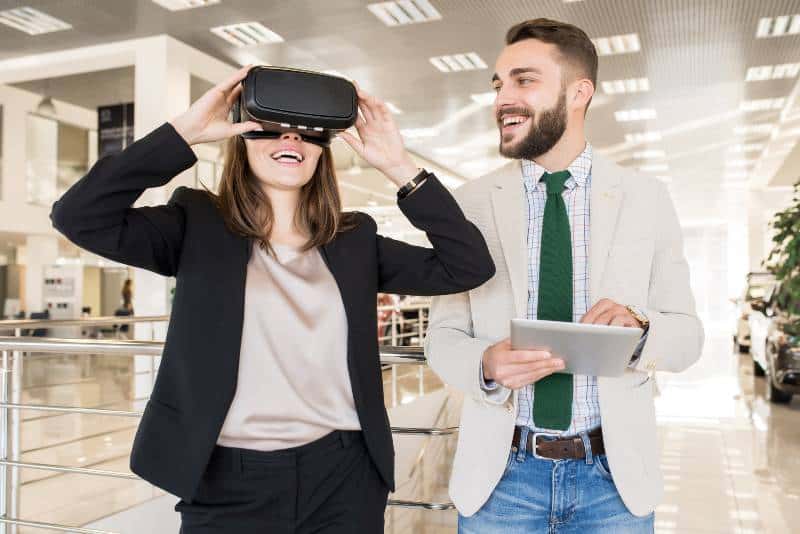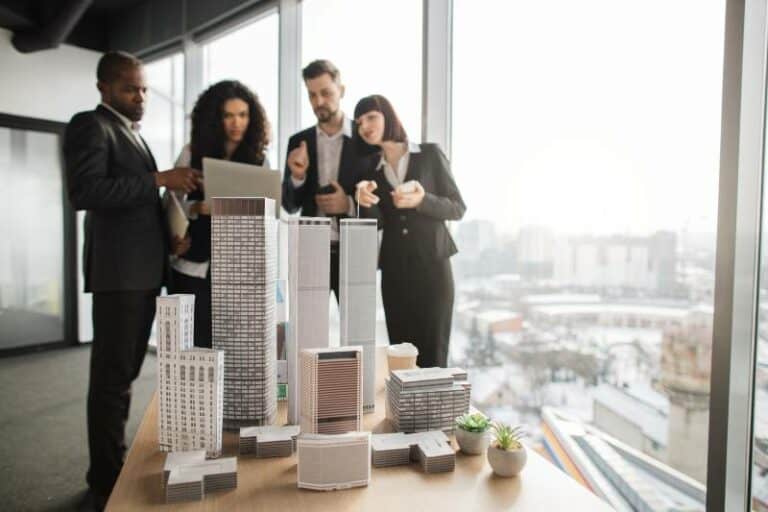Remain at the forefront of all recent advancements in entertainment commercial real estate firms. With automation and mixed-use developments becoming increasingly popular this year, it has become essential to stay informed on these changes. Stakeholders can leverage strategic insights into the commercial real estate market for a successful journey; from making a sound commercial real estate investment that yields high returns while mitigating costs with technological breakthroughs revolutionizing the sector. Don’t get lost trying to navigate 2023 – use your knowledge now to lead you through.
We are living in a period of advanced modernization within commercial and industrial properties, where Smart buildings and AI technologies have become commonplace. Companies now prioritize going green as they construct eco-friendly office space to appeal to today’s environmentally aware tenants. This is truly an age that unites technology and sustainability like never before.
Key Takeaways
- Emerging technologies such as augmented and virtual reality are revolutionizing entertainment companies, allowing companies to craft truly captivating experiences.
- Mixed-use developments offer an attractive option for customers looking for a one-stop shop of fun activities like movie theaters, restaurants, retail outlets – even sustainability initiatives.
- It’s clear that green practices have become a priority in commercial real estate and we’re excited to see how it continues shaping up the scene.
Technology Integration
Use of Virtual and Augmented Reality
Picture being able to virtually enter a property without ever leaving your own house. That’s the power of augmented and virtual reality in real estate! With AR & VR, potential buyers can take part in an immersive experience that is both comprehensive and detailed – giving them a far better understanding of the space they’re viewing, so they can make more informed decisions. By enabling developers and renovators to see changes instantly, time and resources are saved in the design stage. Moreover, this creates a smooth and engaging experience for both buyers and sellers alike throughout the entire transaction process.
Smart Buildings
Smart buildings are revolutionizing the commercial real estate industry, providing an array of benefits to building owners, landlords, and business and property owners alike. With cleaner indoor air and enhanced lighting conditions, worker productivity can increase by up to 23 percent, resulting in increased cost savings and improved attitudes toward employee health and well-being. These intelligent buildings are also providing CRE professionals with the tools to better make investment strategies and manage portfolio risk and assets while creating a competitive edge in the market.
The importance of Cybersecurity
With the rise of digital technology in the entertainment industry, cybersecurity has become a critical aspect of commercial success. The high volume of personal data that companies collect from their customers, investors, and employees presents a tempting target for cybercriminals. Data theft and security breaches have made headlines in recent years, highlighting the importance of investing in comprehensive cybersecurity measures. Businesses must take the initiative to safeguard their sensitive data and protect against unapproved access. Firewalls, and encryption: these are only a few of the latest cybersecurity trends that offer contemporary organizations the tools for keeping digital information secure.
The use of AIs
One of the technology trends is the use of AI. At its very essence, Artificial Intelligence (AI) is a tool of machine learning. This technique allows computers and software to learn from both experience and input in an analogous way to how humans learn.
Let’s take a look at the potential of a basic chatbot. Powered with language and programmed to respond, this smart software will continue to learn from its conversations with users. With each interaction, it can further develop an understanding of the questions asked and how best to answer them – every time advancing in sophistication.
Gradually, the chatbot’s capability to answer a broad scope of questions with greater precision increases. In some cases, it may even be possible for these AI-driven bots to maintain full conversations without the human user being aware that they are conversing with an automated system.
Data is the lifeblood of AI technologies; they enable machines to absorb and analyze extensive datasets, recognizing patterns that inform their learning. It’s understandable why so many people are concerned about the implications of AI. However, it is also essential to recognize that these advancements have their own set of limitations too.
When it comes to learning from data, there are a few issues that arise. For one thing, if the inputted data is incorrect then this will lead to an inaccurate response from AI technology. Additionally, Artificial Intelligence usually has restrictions on what tasks they can do – as they are only capable of performing and learning about a single task or activity. A prime example is that while an AI could be programmed in order to master the game of chess, it would not have the capacity to learn how to play card games.
To put it simply, AI technology may not be able to replicate the capabilities of a human brain. However, that doesn’t mean this technology is useless; in fact, AI has had an enormous impact on the commercial real estate industry.
The Rise of Mixed-Use Developments
The popularity of Entertainment Districts
Mixed-use developments have been on the rise in recent years, offering a unique blend of residential, commercial, and public spaces all in one building. Along with this trend, we are also seeing a surge in the popularity of entertainment districts, which often serve as the focal point of these mixed-use developments. With a variety of options and services, from retail shops to restaurants and cultural amenities, entertainment districts attract both residents and visitors alike.
The lower floors of mixed-use developments house these public spaces, creating a vibrant and welcoming environment for everyone to enjoy. It’s no wonder why these developments are becoming increasingly popular in urban areas and cities – they offer convenience, accessibility, and high quality of life.
The blending of residential and commercial spaces
Over the past few years, mixed-use developments have grown in immense popularity due to their ability to combine residential and commercial aspects into one cohesive environment. These spaces promote an invigorating sense of community that is unlike any other type of development.
With high attention to detail and a focus on making walking easy, these new developments are designed with the pedestrian in mind. Residents and visitors alike can enjoy strolling through areas that provide plenty of opportunity for exploration.
Not only do mixed-use developments provide a range of amenities that promote physical activity and a sense of community, but they are also becoming increasingly popular. With parks, walking paths, fitness centers, and communal outdoor areas all in one spot, these spaces offer residents the chance to work hard and play even harder without having to leave their local vicinity.
Sustainability
Green initiatives
As more and more individuals make the decision to purchase responsibly sourced items, cast their ballots for eco-friendly political parties, and invest in energy-efficient buildings, a new generation of business administrators and lawmakers is emerging on the global stage. These leaders are accelerating change at an unprecedented rate to revolutionize our planet’s stewardship. In order to appease public sentiment, government regulators have introduced stricter regulations on energy consumption and construction.
Businesses with a dedication to sustainability outperform their competitors by being more productive, gaining the interest of talented workers, and often having higher share prices. Real estate investors are also beginning to move away from traditional methods in favor of future-proof strategies that minimize systematic risks while displaying resilience against economic or geopolitical pressures.
Mixed-use developments, which combine residential, commercial, and retail spaces in a single location, are emerging as a solution to this problem.
These developments promote sustainable living by reducing the need for extensive transportation and promoting walking or biking, as well as incorporating green initiatives such as solar panels and energy-efficient lighting.
Use of Renewable Energy
As the property industry is estimated to be producing around 40% of global emissions, private real estate investors are becoming more reliant on renewable energy sources. Industry giants like ESR and CBRE Investment Management have recently declared major investments in green energy projects for their portfolios. This demonstrates how crucial it has become for businesses to prioritize sustainability when investing in properties.
According to the recent ULI Greenprint’s Renewable Energy Strategies for Real Estate report, renewables have rapidly become a crucial energy source in buildings all around the globe, with 4.1 percent growth seen yearly from 2009 to 2019. However, this is just the beginning; renewable energy only accounted for 14.3 percent of total building energy usage as of 2019 – yet in comparison according to US Energy Information Administration projections global building energy consumption will expand at an average rate of 1.3% until 2050.
As the Ukraine conflict further exacerbates our global energy woes and skyrocketing costs, investments in green energy for commercial real estate are likely to escalate. Not only that, but ongoing decarbonization initiatives designed to protect assets from fluctuating regulations and investors’ desires will also gain traction due to growing energy shortages.
Renewable energy systems have become an integral part of buildings, with solar photovoltaic panels, wind turbines, geothermal heat pumps, and hydrogen fuel cells leading the way. According to a PERE logistics webinar audience poll in September 2020, most respondents said they had invested 86 percent in solar-powered devices while 14 percent opted for electric vehicle charging stations — which are often powered by their own type of renewable energy.
The difficulty lies in discovering innovative tactics to incorporate renewable energy sources into existing infrastructure for commercial real estate and making it convenient. For example, companies now have the ability to produce electricity without needing a bulky set-up on their properties through virtual Power Purchase Agreements (PPAs). On top of that, cities all over the world are deploying microgrids which permit them to take advantage of stored battery power during peak hours as well as decrease emissions.
To learn more about sustainability in commercial real estate, read an article that I wrote here to know more about how the power of green initiatives can change the landscape.
Focus on Sustainability in Design and Construction
The emergence of mixed-use developments has sparked an intensified emphasis on sustainability in design and construction. As environmental issues become more prevalent, it is mandatory to minimize the detrimental effects of building projects on the environment and those who inhabit them.
As environmental consciousness grows, so does the need for sustainable design. We must incorporate green elements into construction plans in order to meet the expectations of an increasingly eco-aware public. Designing spaces that are both attractive and practical is now achievable in a way that also benefits the environment, providing comfort to building occupants while safeguarding our planet for generations to come.
Changes in Consumer Behavior
The impact of the Pandemic on the Entertainment Industry
Although chaos has reigned supreme, a novel trend is now in the spotlight: mixed-use developments. Residential, commercial, and retail buildings combined – these types of projects have become increasingly popular over time, yet their growth rate was propelled substantially with the onset of the pandemic.
As remote work continues to become the new norm, customers are on the hunt for spaces that can suit both their professional and individual requirements. Flexibility is key when it comes to finding a workspace that will maximize productivity as well as comfort.
Mixed-use developments provide the convenience and sense of community that has become essential in these times, allowing you to live, work and play all at the same location. Not only do they offer an excellent opportunity for those who are looking to set up a new business or build a lifestyle around their hobbies – having everything within easy reach is invaluable during this age of social distancing.
Increasing focus on Health and Wellness
The Well Living Lab in Rochester, Minnesota is a joint venture between The Mayo Clinic and Delos that spans 5,500 square feet. Its purpose? To evaluate indoor conditions and produce data-driven solutions for creating healthier workspaces. Their state-of-the-art facility can replicate both open-plan offices or private rooms where participants are monitored via sensors as well as wearable biometric technology – ensuring the accuracy of their findings.
Beneficial insights for planners, architects, funders, occupants, and owners of built spaces are derived from the research conducted at this site. For instance, one particular project revealed that workers’ capacity to complete tasks in open areas is more profoundly impacted by temperature rather than either noise or illumination levels.
Landlords and tenants alike are frequently attempting to gauge the return on their investment in wellness features. Recent data from stõk, a real estate management company specializing in High-Performance Buildings (HPBs), has reported that thermal comfort, air quality, and design elements generate the most returns out of all available wellness options.
A recent research study entitled “The Financial Case for High-Performance Buildings” found that a $20/sf investment in HPBs typically yields an impressive 3% increase in profits due to higher productivity. The majority of this gain comes from reduced absenteeism (43%) and employee retention rates (41%), with wellness, utility savings, and maintenance costs contributing the remaining balance at 7%, 7%, and 2% respectively.
Although the effectiveness of wellness strategies may be questioned without sufficient data, it is apparent that there is a strong demand for such spaces. According to BusinessWire, in recent research conducted by CBRE in conjunction with Maastricht University, 38% of urban office space across America has eco-friendly features incorporated into its design; Chicago emerging as the main proponent with an astounding 66%. Therefore, we cannot simply dismiss this trend as mere window dressing and must consider how to market support can strengthen health and productivity effects.
The need for Flexibility
In this current era of perpetual transformation, flexibility has become pivotal for success – especially in the real estate industry. Mixed-use developments have been booming in popularity as a result. Historically, real estate development was geared towards creating single-use structures such as multifamily properties, and residential or commercial buildings.
Nowadays, more and more individuals are searching for convenience in their lives. Fortunately, blended-use developments have been established to meet this need – these projects mix a variety of uses such as residential, commercial, and recreational areas into one unified project that results in an exciting and multifaceted community.
Emerging Trends in Entertainment Commercial Real Estate FAQs
Why is it important to stay informed on emerging trends in this industry?
It is important to stay informed on emerging trends in the entertainment commercial real estate industry because this sector of the market is continually evolving. Staying up to date helps developers and brokers make better decisions when it comes to purchasing, leasing, developing, or investing capital in a particular property.
How is technology being integrated into Entertainment Commercial Real Estate?
Today, tech companies are seeking out spaces that can meet their needs – think high-speed internet and other infrastructure. Plus smart building technologies are helping to reduce energy waste while improving tenant comfortability in a variety of ways.
What are mixed-use developments and why are they becoming more popular?
Mixed-use developments are properties that combine different uses, such as residential, commercial, and retail spaces. These types of projects have become increasingly popular due to the convenience they offer tenants. In addition, they provide a sense of community and flexibility that is attractive to both employers and employees.
What is the importance of sustainability in this industry?
Developers in the entertainment industry are rallying behind sustainability. By outfitting properties with forward-thinking features like renewable energy and green roofs, they’re not only making them more attractive to tenants but doing their part for our planet as well. It’s a win-win situation that stands to benefit everyone involved.
How has consumer behavior changed in the Entertainment Commercial Real Estate industry?
As the way we live continues to evolve, so too are innovative new projects that offer convenience and variety. Mixed-use developments provide a unique opportunity for entrepreneurs looking to capitalize on this shift in consumer behavior — combining different facets of business into one unified space.
What impact has the pandemic had on this industry?
Despite a brief downturn in prices during the initial COVID-19 outbreak, commercial real estate is beginning to rebound. However, not all regions are recovering at the same rate; some areas and segments of the market have returned more quickly than others.
Conclusion
Entertainment Commercial Real Estate is an ever-evolving industry that constantly shifts to keep up with the changing economy and landscape of trends. To stay ahead in this field, it’s crucial to remain flexible and adaptable – a key factor for any successful business.
It’s time to take on the challenge and unleash your creativity! Step into a world of possibility with new technologies such as Cybersecurity, or spark fun in Entertainment Districts. You can even make an impact by focusing on Renewable Energy Sources for your building – now that could be something special.
With the world around us changing, it can be difficult to know what steps you need to take for pursuing your business goals. I’m here and ready to help! Feel free to contact me if you want guidance on navigating these changes – a no-cost consultation is available today.
Blog Articles Disclaimer
The information presented in articles on our website or affiliated platforms is exclusively intended for informational purposes. It’s crucial to grasp that this content does not constitute professional advice or services. We strongly recommend our readers to seek guidance from appropriately qualified experts, including, but not limited to, real estate and other attorneys, accountants, financial planners, bankers, mortgage professionals, architects, government officials, engineers, and related professionals. These experts can offer personalized counsel tailored to the specific nuances of your individual circumstances. Relying on the content without consulting the relevant experts may hinder informed decision-making. Consequently, neither Tolj Commercial Real Estate nor its agents assume any responsibility for potential consequences that may arise from such action.






